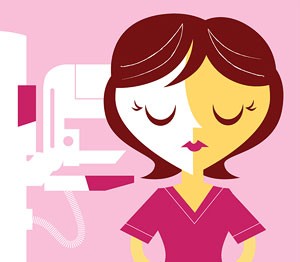Ever wonder how often you should get a mammogram?
A mammogram is a x-ray image of the breast and women usually over the age of 40 go for a screening mammogram. Screening mammograms are breast exams to make sure women are healthy and have no symptoms of developing cancer. This test helps to increase the chances of catching cancer in its earlier stages and to stop it from spreading. Mammograms are interpreted by looking at the fatty tissues on the breasts. The dense breast tissue appear as a solid white area while the fat appears as a dark area. Although there are many positives about screening mammograms, here are 5 mammogram guidelines you need to know about.
1. It is your choice. While the U.S. Prevention Services Task Force recommend women getting a screening every 2 years after the age of 50, Mayo Clinic and The American Cancer Society suggest women getting a screening annually after the age of 40. It is up to you to decide how often you want to get a mammogram. Depending on your health, family history, age, etc. you have a choice as to how often you can get checked.
2. Reduces the risk. Technology is not perfect however, it is constantly improving. This concept also applies to the screening mammogram machine. Getting a screening will reduce the chances of the cancer spreading. The machine will detect any abnormalities in the breasts which will help catch any tumors that may be forming. Since the abnormality would be detected in its early stages, treating it will be easier and the risk of it spreading also decreases.
3. Detect what exams cannot. Breast exams exist to make sure, as a woman, you are healthy and there are no abnormalities forming or existing in your breasts. Screening mammograms are different from the clinical breast exams. The clinical breast exams are taken when visiting the doctor for a physical or you can even take this exam on your own. Checking one’s own breasts for any lumps or differences is called a breast self-exam (BSE). The screening differs from the clinical exam and BSE is that in getting a screening mammogram malignant tumors can be detects and it is one of the most effective ways to discover breast cancer.
4. False-positive and false-negative. Building off of #2 and #3, because the screening mammogram machines are not perfect they have the possibility of detecting, or not detecting, something that is not harmful to the body. The National Cancer Institute states that “Overall, screening mammograms miss about 20% of breast cancers that are present at the time of screening.” A false-positive is when the machine detects an abnormality when there in reality one does not exist. For example, the mammogram could show that a patient has cancer developing when in reality it could be an error in the machine, dense breast tissue, or even a benign tumor. This diagnosis could lead to additional testing, over-treatment, anxiety, or other forms of stress. On the flip side, a false-negative is when the machine does not detect an abnormality however, there is one. An scenario is when a patient might have a family history of breast cancer however, the mammogram results does not show a cancerous tumor. This diagnosis could also lead to additional testing and more danger for the patient since the cancer might get out of hand before it is detected and diagnosed as malignant.
5. Radiation from x-ray. Women know that when they get a mammogram done, they get an x-ray of their breasts. The x-ray gives a very small dose of radiation. Although it is a small amount, radiation can be harmful if exposed to it repeated times. The risk of being harmed from this radiation is extremely low and most of the time the benefits outweigh the harms but the harms do exist.
As you can tell there are both pros and cons to getting screening mammograms and these are just 5 mammogram guidelines.
To find out more about mammogram guidelines, click here.
Find out more facts about mammograms from National Cancer Institute.



